![]()
![]()
![]()
Use LEFT and RIGHT arrow keys to navigate between flashcards;
Use UP and DOWN arrow keys to flip the card;
H to show hint;
A reads text to speech;
168 Cards in this Set
- Front
- Back
|
Describe Histamine's location, function, and properties for release
|
Preformed substance found in: Mast cells, basophils, platelets
Vasodilation of arterioles Increases permeability of venules Released due to: Physical injury, IgE, C3a/C4a, IL-1, PLT aggregation,... |
|
|
Describe Serotonin's location, function, and properties for release
|
Found in: Platelets and enterochromaffin cells
Vasodilation of arterioles Increased permeability of venules Released due to: Physical injury, IgE, C3a/C4a, IL-1, PLT aggretation,... |
|
|
Describe Leukocyte adhesion deficiency Type I and Type II
|
Type I: Defect in biosynthese of B2 (No firm adhesion form VCAM-1 or ICAM-1)
Type II: Absence of sialylated oligosaccharides receptor for E and P selectins (No Rolling/Loose Adhesion) |
|
|
Describe the genetic representation of Chronic Granulomatous Disease and what happens?
|
X-Linked (Defect in membrane NADPH - No oxidative "Burst")
Autosomal Recessive (defect in cytoplasmic NADPH oxidase Common to get infections |
|
|
Describe the genetic representation of myloperoxidase deficiency (MPO-Deficiency) and what happens
|
Absent MPO-H2O2 system (No oxidative "Burst")
Most common Neutrophil Defect Common to acquire infections |
|
|
Describe the genetic representation of Chediak-Higashi Syndrome and what happens
|
Autosomal recessive
Lysosomes cannot fuse w/ phagosomes Lysosomes become large (No phagocytosis) Neutropenia, albinism, nerve defects, bleeding, and Immunodeficiency Common to acquire infections |
|
|
Define Sinus tract and the following exudates: serous, fibrinous, Catarrhal, purulent/suppurative, hemmorhagic, and fibrinopurulent.
|
Sinus Tract: Passage or path formed by discharge of a deep abscess to the surface of skin or a mucosal membrane
Serous - serum like exudate Fibrinous - fibrin rich exudate Catarrhal - exudate from mucous membranes purulent/supperative - leukocyte rich exudate hemmorrhagic - bloody exudate fibrinopurulent - inflammatory edema fluid containing puss and fibrin |
|
|
What does DAF stand for, what does it do, and what happens if you are deficient in it?
|
Decay-Accelerating Factor
Located in cell membrane - dissociation/cleaving of C3b Defect: causes Paroxysmal Nocturnal Hemoglobinuria (intravascular hemolysis/anemia at night while sleeping) |
|
|
What is C1INH and what does it do and what happens if you are deficient?
|
C1 inhibitor
Plasma protein Blocks C1 binding to immune complexes Defect: causes stress, trauma of skin, larynx and intestines known as Hereditary angioneurotic edema |
|
|
Name the chemotactic agents?
|
C5a, LTB4, IL-8, kallikrein and there are others, but I don't have them in front of me...
Exogenous: N-formyl-methionine (on bacteria) |
|
|
What does bradykinin do?
|
Increases permeability
Vasodilation Bronchiolar smooth muscle contraction Pain Inactivation of kininases/angiotensin converting enzyme |
|
|
What does release of kallikrein do?
|
Autoamplification
Chemotaxis C4a formation |
|
|
What does Plasmin do?
|
Cleaves C3 and forms C3a
degrades fibrin to form fibrin split products (permeability; vasoactive mediators) activates hageman factor (XII) for amplification |
|
|
What are the inflammatory actions of the prostaglandins?
|
PGI2 (Endothelium) - Vasodilation
PGE2 - Vasodilation and pain Thromboxane A2 (Platelets) - Vasoconstriction |
|
|
What are the inflammatory actions of the Leukotrienes?
|
LTC4, D4, and E4 - vasoconstriction, increased permeability
LTB4 - powerful chemotaxis |
|
|
What does PAF stand for and do?
|
Platelet activating factor
Platelet stimulation, vasoconstriction, and bronchoconstriction |
|
|
What do IL-1 and TNF do?
|
Endothelial "activation": Increased leukocyte adhesion, synthesis of PGI2, Thrombogenicity, Secretion of other cytokines (IL-1, IL-8, PDGF)
Fibroblasts (Involved in repair and fibrosis): increased collagen synthesis, fibroblast proliferation Acute phase response: fever, neutrophilia, sleep, decreased appetite, hypotension |
|
|
What are the chemokines and what do they attract?
|
IL-8: Neutrophils
Monocyte Chemoattractant Protein: Monocytes Macrophage INflammatory Protein: Macrophages RANTES (Regulated and normal T-Cell expressed and Secreted): all cell types except neutrophils |
|
|
What causes increased vascular permeability?
|
Histamine
Anaphylatoxins (C3a and C5a) Kinins Leukotrienes (C, D, E) PAF |
|
|
What causes Vasodilation?
|
PGI-2
PGE-2 Nitric Oxide |
|
|
What are chemotactic?
|
C4a, LTB4, chemokines (IL-8), N-fmet
|
|
|
What is acute phase reaction and what causes it?
|
It is: fever, neutrophilia, sleep, decreased appetite, hypotension
caused by: IL-1 and TNF |
|
|
What causes fever?
|
IL-1, TNF, and PGs
|
|
|
What are the anti-proteases that prevent tissue damage?
|
Alpha-1 antitrypsin
Alpha-2-macroglobulin |
|
|
What causes chemokines cause pain?
|
PGs and Bradykinin, oh and Substance P
|
|
|
Where is neuropeptide substance P from and what does it do?
|
From Lung and GI
causes Pain and increased vascular permeability |
|
|
what produces IFN-Gamma and what does it do?
|
Produced by lymphocytes and causes macrophage activation
|
|
|
What are the big 3 of chronic inflammation (the cells)?
|
Macrophages
Lymphocytes Plasma Cells |
|
|
What are the four R's of Immunity?
|
Recognize the Antigen
Recruite the appropriate cells/factors Removal Repair |
|
|
Of the 4 R's of immunity what does it mean recognize the antigen?
|
Interleukin-1 alpha/beta and TNF alpha/beta
Induce expression of adherance molecules Induce cytokine networks induce physiological changes (Fever, increased pulse/blood pressure) |
|
|
Of the 4 R's of immunity what does it mean Recruit the appropriate cells/factors?
|
Interleukin-8: Polymorphonuclear leukocyte chemotaxin and T-lymphocyte chemotaxin
Monocyte chemotactic protein -1 (from Activated T-Cells): Peripheral blood monocyte chemotaxin andperipheral blood monocyte activator |
|
|
Of the 4 R's of immunity what does it mean Removal?
|
Interferon Gamma: Increases MHC expression, increases killing activity of phagocytes, increases Fc receptor (for antibodies) expression, activates macrophages
Interleukin-4: increases killing activity of phagocytes and stimulates B-cell maturation (Lymphocytes --> B-cells) Interleukin-6: Stimulates acute phase response and stimulates antibody synthesis |
|
|
Of the 4 R's of immunity what does it mean Repair?
|
TGF-beta: stimulate cell proliferation and increase collagen production
FGF - stimulates fibroblast growth and stimulates growth of new blood vessels VEGF - promotes angiogenesis |
|
|
What secretes IL-2 and what does it do?
|
T-cells can secrete IL-2 to activate more T-cells in a granulomatous inflammation response.
|
|
|
What are the Primary histologic features of granulomatous inflammation?
|
Angiogenesis and fibrosis
|
|
|
In granulomatous inflamation what causes angiogenesis?
|
FGF and VEGF promote angiogenesis and increase vascular permeability
|
|
|
In granulomatous inflammation what causes fibrosis?
|
Migration and proliferation of fibroblasts at site of injury triggered by TGF-beta, PDGF, EGF, FGF cytokines, IL1 and TNF alpha.
(Macrophages release the TGF-beta, PDGF, and FGF) |
|
|
What is the timeline for healing of a myocardial infarct?
|
7-10 days: early formation of fibrovascular granulation tissue at margin
10-14 days: Well established granulation tissue with collagen deposition 2-8wks: increased collagen deposition with decreased cellularity >2months: Dense collagenous scar |
|
|
What happens in a cerebral infarct?
|
Liquifactive necrosis resulting in a cyst
No fibrosis/scarring Some gliosis around margins |
|
|
Where is PDGF stored, why is it released, and what releases it?
|
Stored in platelet alpha granules
Released upon activation ot cause migration and proliferation of fibroblasts, smooth muscle cells and monocytes Can be made by: macrophages, endothelial cells, smooth muscle cells, and tumor cells |
|
|
What are the functions of FGF?
|
Angiogenesis
Wound repair development and hematopoiesis |
|
|
What is the function of VEGF
|
AKA vascular permeability factor
Functions in vasculogenesis and angiogenesis |
|
|
What makes TGF-Beta and what does it do?
|
Produced by Platelets, endothelial cells, and macrophages
It is chemotactic for monocytes cuases angiogenesis Has a wide range of inhibitory and stimulatory effects Favors fibrogenesis during wound repair MOST IMPORTANT: Growth factor responsible for repair by connective tissue/healing |
|
|
Describe Histamine's location, function, and properties for release
|
Preformed substance found in: Mast cells, basophils, platelets
Vasodilation of arterioles Increases permeability of venules Released due to: Physical injury, IgE, C3a/C4a, IL-1, PLT aggregation,... |
|
|
Describe Serotonin's location, function, and properties for release
|
Found in: Platelets and enterochromaffin cells
Vasodilation of arterioles Increased permeability of venules Released due to: Physical injury, IgE, C3a/C4a, IL-1, PLT aggretation,... |
|
|
Describe Leukocyte adhesion deficiency Type I and Type II
|
Type I: Defect in biosynthese of B2 (No firm adhesion form VCAM-1 or ICAM-1)
Type II: Absence of sialylated oligosaccharides receptor for E and P selectins (No Rolling/Loose Adhesion) |
|
|
Describe the genetic representation of Chronic Granulomatous Disease and what happens?
|
X-Linked (Defect in membrane NADPH - No oxidative "Burst")
Autosomal Recessive (defect in cytoplasmic NADPH oxidase Common to get infections |
|
|
Describe the genetic representation of myloperoxidase deficiency (MPO-Deficiency) and what happens
|
Absent MPO-H2O2 system (No oxidative "Burst")
Most common Neutrophil Defect Common to acquire infections |
|
|
Describe the genetic representation of Chediak-Higashi Syndrome and what happens
|
Autosomal recessive
Lysosomes cannot fuse w/ phagosomes Lysosomes become large (No phagocytosis) Neutropenia, albinism, nerve defects, bleeding, and Immunodeficiency Common to acquire infections |
|
|
Define Sinus tract and the following exudates: serous, fibrinous, Catarrhal, purulent/suppurative, hemmorhagic, and fibrinopurulent.
|
Sinus Tract: Passage or path formed by discharge of a deep abscess to the surface of skin or a mucosal membrane
Serous - serum like exudate Fibrinous - fibrin rich exudate Catarrhal - exudate from mucous membranes purulent/supperative - leukocyte rich exudate hemmorrhagic - bloody exudate fibrinopurulent - inflammatory edema fluid containing puss and fibrin |
|
|
Describe Local Anaphylaxis and give some examples
|
Localized reactions ot allergens
e.g. hayfever (Allergic Rhinitis), Urticaria (hives), Asthma, and Angioedema (recurrent large circumscribed areas of subcutaneous edema of sudden onset, usually disappearing within 24 hours.) |
|
|
Describe systemic anaphylaxis
|
Characterized by vascular shock, widespread edema and difficulty breathing
|
|
|
What is Kernicterus and what are the characteristics of it?
|
Condition that occurs in premature infants which involves the movement of bilirubin into the brain due to incomplete formation fo the blood brain barrier.
Caused by deposition of bilirubin which causes destruciton of the basal ganglia and thalamus, leading to irreversible neurologic abnormalities |
|
|
What is Acid hematin?
|
Formed when gastric acid mixes with blood
Pigment look like coffee grinds Seen in the vomit of individuals with bleeding peptic ulcers |
|
|
What is Hemochromotosis
|
Disease characterized by hemosiderosis
Frequently a genetic disorder Massive accumulation of hemosiderin in hepatic and pancreatic parenchymal cells, myocardium and other sites (Classic triad of cirrhosis, diabetes mellitus, and increased skin pigmentation. Patients have bronze pigmentation due to melanocyt hyperplasia) |
|
|
In hemochromotosis what is the classic triad?
|
Cirrhosis
Diabetes Mellitus Increased skin pigmentation |
|
|
What is Hematoidin?
|
Closely related to bilirubin
Does not contain iron (So it doesn't not stain with potassium ferrocyanide) Found in infarcted areas, such as a splenic infarct Appears as a "Sunburst" (Golden crystalline pigment) |
|
|
What is a Psommoma body?
|
Seen in certain types of neoplasms
Calcification of a single necrotic cell |
|
|
What is a Russell Body
|
Granules of immunoglobulins within plasma cells
|
|
|
What is hyaline?
|
Descriptive term for any material that is microscopically eosinophilic, refractive, glassy looking and amorphous
|
|
|
What is Goodpasture syndrome (Anti-GBM disease) and name its hypersensitivity?
|
Antibodeis against non-collagenous protein in the basement membrane of kidney glomeruli and lung alveoli
Hypersensitivity Type II |
|
|
What is Bullous Pemphigoid and what is the hypersensitivity associated?
|
Skin disease that have antibodies that attach to the subepidermal-epidermal interface
Bulla is like large fluid-filled blloon tha toccurs in clumps about half a cm large. Skin practically sloughs off Type II Hypersensitivity |
|
|
What is pernicious anemia and its associated hypersensitivity?
|
Antibodies against intrinsic factor decreaseing vitamin B12 absorption
Type II |
|
|
What is sjogren sysndrome
|
Keratoconjunctivitis Sicca (dry eyes) and xerostomia (dry mouth)
Immunological destruciton of lacrimal and salivary glands |
|
|
What is Systemic Sclerosis?
|
Abnormal accumulation of fibrous tissue
Skin hardening and increase in dermal collagen Affects muscular motility in esophagus Vascular diseaes, causes thickening of media vessels Patients die of renal failure, malnutrition, or infection |
|
|
What is dermatomyositis/Polymyositis?
|
Disorder of the skin and skeletal muscles characterized by skin rash and muscle weakness
(Polymyositis is similar does not involve skin) |
|
|
What is mixed connective tissue disease
|
Features of rheumatoid, scleroderma, and lupus
|
|
|
What is rheumatoid arthritis
|
Antibodies against an antigen in the joint synovium
|
|
|
What is polyarteritis Nodosa
|
Antibodies against media walls of vessels
|
|
|
Describe the primary immunodeficiency Bruton (X-linked) agammaglobulinemia
|
Failure of B-cells precursers ot mature into b-cells therefore make no antibodies.
Patients can get periodic gammaglobulin injections containing antibodies from othe rpeople or get bone marrow transplant. |
|
|
What is Isolated IgA primary immunodeficiency?
|
Don't have the gene to make IgA molecule
Secrety protection is compromised Most common with 1 in 500 |
|
|
What is Severe combined immunodeficiency (SCID)a primary immunodeficiency
|
defect in humoral nad cell mediated immune responses
Two types: X-linked Autosomal Recessive (Adenosine deaminase deficiency) |
|
|
What is pleomorphism?
|
Variation in size and shapes of cell as well as staining intensity
|
|
|
What are the carcinogens and what kind of cancer do they cause?
|
Benzanthracene (skin cancer, sarcomas).
Benzopyrene in tobacco smoke (lung cancer). Beta-naphthalamine (bladder cancer) Nitrosamines (gastric cancer). Nitroso compounds in tobacco smoke (lung cancer). Asbestos (lung cancer, mesothelioma). Vinyl chloride (hemangiosarcoma of liver). Arsenic (skin cancer). Chromium, nickel, other metal (lung cancer). Aflatoxin (Liver cancer). |
|
|
What do oncogenes code for?
|
Growth Factors (sis)
Growth Factor Receptors(erb) Signal Transucing Proteins (ras) Nuclear Regulatory Proteins (myc) |
|
|
What is Li-Fraumeni syndrome?
|
Inherited mutant copy of p53
|
|
|
What is Cushing's Disease?
|
hypercortisolism secondary to excess production of adrenocorticotropin (ACTH) from a pituitary gland adenoma.
|
|
|
What are the characteristics of Cachexia?
|
Loss of body fat
Loss of lean body mass Profound weakness Anorexia Anemia |
|
|
What are the characteristics of paraneoplastic syndromes and some examples?
|
Fever of unknown origin:
Lymphomas (especially Hodgkin's disease), renal carcinoma, osteogenic sarcoma. Endocrine Syndromes: Cushing's Syndrome (due to ACTH) - small cell (oat cell) carcinoma of lung. Hyponatremia ( ADH) Small cell carcinoma of lung. Hypercalcemia ( PTH) Squamous cell carcinoma of lung, breast and renal carcinoma. |
|
|
Name some other examples of paraneoplastic syndromes
|
Hypoglycemia: Sarcomas, liver cancer
Carcinoid Syndrome: (Serotonin, histamine, bradykinin) Bronchial carcinoid, Metastatic carcinoid to liver. Polycythemia: (Erythropoietin)Renal cell carcinoma Neurologic and Muscle Syndromes, Peripheral neuropathy, Dermatomyositis, Polymyositis: Small cell carcinoma of lung Myasthenia Gravis: Thymoma Acanthosis nigricans: Gastroentestinal cancer Clubbing of fingers, Hypertrophic osteoarthropathy: Lung cancer Migratory thrombophlebitis, Deep vein thrombosis: Pancreatic cancer, GI tract cancer, lung cancer. |
|
|
How do you calculate HDL ratio?
|
LDL/HDL
|
|
|
Can you calculate VLDL or do you measure it?
|
You calculate for it based on the triglyceride levels
|
|
|
What is the objective of the Atkins diet and what does that have to do with cholesterol levels?
|
Nothing to do with cholesterol.
Atkins targes slimness irrespective of cholesterol because obesity is correlated to mortality |
|
|
How do you calculate BMI?
|
Body weight in kg / height in meters squared
|
|
|
How does being morbidly obese affect mortality ratio?
|
It doubles it by increasing the amount of health problems
|
|
|
It indicates that a person who is more obese at a younger age will have lost more years to their life than an older person
|
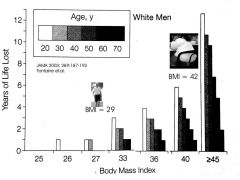
What does the trend of life chart indicate with regards to younger more obese individuals?
|
|
|
What does metabolic syndrome mean and name three of the things requred to be part of that group
|
Insulin resistance syndrome
Defined by: Fasting glucose > 110 mg/dl (insulin resistance) Abdominal obesity (waist girth > 102 cm i.e. 40 inches) Serum triglycerides > 150 mg/dl Serum HDL-cholesterol < 40 mg/dl Blood pressure > 130/85 mm Hg |
|
|
What are two procedures of bariatric surgery?
|
Rous en-Y gastric bypass
Vertical Banded Gastroplasty |
|
|
What is Rous en-Y gastric bypass?
|
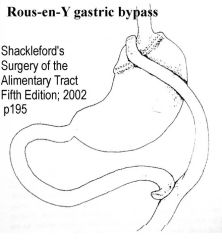
Stomach is taken ouf of loop so food never gets into stomach
Little bit of stomach is left to anastomose the jejunum up to the esophagus which brings food straight from esophagus to jejunum other arm of Y carries bile and pancreatic juices |
|
|
What is Vertical banded gastroplasty?
|
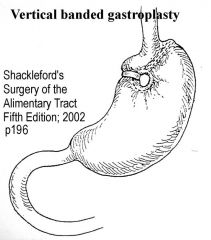
"stomach stapling"
stomach remains in loop but there is a constriction, which slows flowing of food into stomach The constriction is made by using a staple with a band around it to prevent it from opening over time |
|
|
What is glycemic index and how do you measure it?
|
It is a ratio of the glucose tolerance curve
Demonstrates how different carbohydrates affect glucose levels Measured by taking: Area under experimental (Carbohydrate) curve / Area under baseline (glucose) curve |
|
|
Can a high glycemic index food be lowered during consumption?
|
yes. If the starches are eaten with somehting else the glycemic index can be reduced
|
|
|
What is the reasoning for low glycemic index foods causing a decrease in appetites yielding less obesity?
|
whole grain foods and low glycaemic index foods are emerging as dietary constituents that appear to reduce the likelihood of disease complications by reducing risk factors for the insulin-resistant diseases...A reason for the effects...Is evidently based on slowing the rate of absorption and creating a late reservoir in the small intestine..
|
|
|
What does Glucagon-like Peptide 1 (GPL-1) do and where does it come from?
|
released by the small intestines when there are carbohydrates being absorbed to suppress apetite
|
|
|
What effects does obesity have on health issues?
|
Knee osteoarthritis, since it adds more weight to be supported
MORBIDLY obese, there is an increase incidence of hip replacement |
|
|
What is Marasmus?
|
Malnutrition caused by severe reduction in caloric intake
Greater than 60% reduction in body weight adjusted for height and weight Child shows growth retardation and loss of muscle Chronic illness occurring over months |
|
|
Waht is Kwashiokor?
|
protein deprivation greater than the reduction in total calories
Marked protein deprivation associated with severe loss of visceral protein compartment weight is generally 60-80% of of normal weight for their age Acute illness occurring over weeks |
|
|
What is Pellagra?
|
Deficiency of niacin or tryptophan
Among alcoholics and persns suffereing from chronic dehabilitiating disease (such as HIV) Causes 3 D's (Diarrhea, dermatitis, and dementia) |
|
|
What is Beriberi?
|
Deficiency in thiamine
Associated with peripheral vasodilation, leading to more rapid arteriovenous shunting of blood, high-output cardiac failure and eventually, peripheral edema |
|
|
What is Niacin
|
I can't believe you are trying to answer this question! Fine!
It is a generic designation for nicotinic acid. Plays central role in dehydrogenase reactions, particularly hexose-monophosphate reaction |
|
|
What is Thiamine?
|
Again??
Vitamin in the diet found in such refined foods as polished rice, white flour and white sugar contain little Regulate oxidative decarboxylation of alph-keto acids, leading ot synthesis of ATP |
|
|
What is protein-energy malnutrition (PEM)
|
Clinical syndromes characterized by an inadequate dietary intake of protein and calories to meet the body's needs
|
|
|
What is somatic protein
|
one of the two protein compartments in the body, which is represented by skeletal muscle
|
|
|
What is Visceral protein
|
Other protein compartment represented by protien stores in visceral organs, primarily the liver
|
|
|
What causes neural tube defects?
|
Folic acid lack during pregnancy (essential cofactor in nucleic acid synthesis)
|
|
|
What is Rickets
|
deficiency in Vitamin D in growing children
Overproduction and deficient in calcification of osteeoid bone Associated skeletal abnormalities Disturbances in growth Hypocalcemia |
|
|
What is proband?
|
Patient who is affected in a pedigree
|
|
|
What are the two most common causes of death (They are genetic disorders)?
|
Cardiovascular disease
Cancer |
|
|
What are the characteristics of Mendelian Disorders?
|
Imply involvement of single gene
Imply mutation of the gene Display characteristic family pedigrees and inheritance patterns More than 5000 described diseases Everyone carries 5-8 abnormal genes |
|
|
What is reduced penetrance?
|
Abnormal gene but you don't display the diesease phenotypically
|
|
|
What is Variable expressivity?
|
Abnormal gene manifests itself differently into varying severies in each person
|
|
|
what are three questions to ask in analysis of inheritence patterns?
|
Are both males and females affected?
Is every generation involved? Is there male to male transmission? |
|
|
Based on the three questions of determining inheritence patterns what would be the answers for an Autosomal Dominant?
|
Are both males and females affected? Yes
Is every generation involved? Yes Is there male to male transmission? Yes |
|
|
Based on the three questions of determining inheritence patterns what would be the answers for an Autosomal Recessive?
|
Are both males and females affected? Yes
Is every generation involved? No Is there male to male transmission? Unknown |
|
|
Based on the three questions of determining inheritence patterns what would be the answers for an X-Linked Dominant?
|
Are both males and females affected? Yes
Is every generation involved? Yes Is there male to male transmission? No |
|
|
Based on the three questions of determining inheritence patterns what would be the answers for an X-Linked Recessive?
|
Are both males and females affected? No
Is every generation involved? Yes Is there male to male transmission? No |
|
|
What is the pattern of inheritence for an Autosomal Dominant?
|
Males = Females
Disease appears in every generation No carrier state (Have it or not) Recurrrence risk is 50% |
|
|
What are the characteristics of Marfan syndrome?
|
Skeletal: Disproportionate (Key) tall stature, arachnodactyly, pectus excavatum
Ocular: myopia, upwards lens dislocation CVS: mitral valve prolapse, thoracic aortic root aneurysm / dissection 1/5000 Fibrillin-1 gene (chrom 15) > 500 types of mutations(missense= #1) 30% are new mutations AUTOSOMAL DOMINANT |
|
|
What are the characteristics of neurofibromatosis-1 (NF1)?
|
Skin: Café au laits (>6), axillary freckling, neurofibromas
Eyes: Lisch nodules, optic glioma Neuro: Learning disability Rare: cancer, HTN,pheochromocytoma 1/3000 Neurofibromin gene (chrom 17), a tumor suppressor gene 50% are new mutations AUTOSOMAL DOMINANT |
|
|
What are the characteristics of Ehlers-Danlos syndrome?
|
AUTOSOMAL DOMINANT
> 5 variants Skin: hyperextensible, keloids Joints: hypermobile Artery and viscera rupture (Type IV) Retinal detachment (Type VI) Diaphragmatic hernia (Type I) Genetic heterogeneity: mutations at several loci (genes) produce same trait Collagen genes (type I-IV); autosomal dominant Lysyl hydroxylase gene (type VI); autosomal recessive |
|
|
What are the characteristics of Familial Hypercholesterolemia?
|
AUTOSOMAL DOMINANT
Most common Mendelian disorder 3-6% of MI survivors 1/500 LDL receptor gene (chrom 19)->900 different mutations (deletions, point mutations) |
|
|
What are the characteristics of adult polycystic kidney disease?
|
AUTOSOMAL DOMINANT
Large kidneys with multiple, bilateral cysts Renal failure in 50s 40%: hepatic cysts or berry aneurysms (cause 10% of APCKD deaths) 25% with heart defects (MVP) 1/600 5-10% of chronic renal failure Genetic heterogeneity: PKD1 gene (85%)(chrom 16); PKD2 gene (15%)(chrom 4) |
|
|
What are the characteristics of tuberous Sclerosis Disorder?
|
AUTOSOMAL DOMINANT
Tubers’ (tumors) of: brain, kidney, eye, heart, fingernails Skin: hypopigmented patches CNS: mental deficiency, seizures Genetic heterogeneity: Tuberin gene (chrom 16) Hamartin gene (chrom 9) |
|
|
What are the characteristics of Autosomal Recessive Diseases?
|
Manifests in homozygous state
Heterozygotes are carriers and unaffected Classically congenital or early-onset diseases Involves defective enzymes Does not display variable expressivity, reduced penetrance, or new mutation phenomena |
|
|
What is the inheritance pattern of Autosomal Recessive?
|
Males=Females
Appears only in siblings of same generation Higher likelihood of consanguinity Recurrence risk is 25% for carrier parents |
|
|
What are the characteristics of tyrosine negative albinism?
|
Autosomal RECESSIVE
Little pigmentation in skin, hair and eyes Nystagmus or strabismus Tyrosinase gene mutation (chrom 11) Results in decreased melanin |
|
|
What are the characteristics of PKU?
|
Autosomal RECESSIVE
Fair pigmented “Mousy” odor at birth Untreated: mental retardation, seizures, paraplegia Treated: relatively normal. 1/10,000 whites Phenylalanine hydroxylase gene(chrom 12) The prototype for the newborn screening program Treatment: severe dietary restriction of phenylalanine “Congenital PKU”: a teratogenic, neonatal disease That only occurs when mom has PKU. Not inherited |
|
|
What are the characteristics of Sickle Cell Anemia?
|
Autosomal RECESSIVE
Anemia Vasoocclusive crises in bones, lungs, brain Pain crises Priapism Autosplenectomy and infections Howell Jolly bodies Sickled RBCs (drepanocytes) globin gene mutation (chrom 11) Missense mutation: glutamine to valine 1/14 blacks are carriers Carriers resistant to malaria |
|
|
What are the characteristics of Cystic Fibrosis?
|
Autosomal RECESSIVE
Recurrent infections, cirrhosis, diabetes, pancreatic insufficiency, bronchiectasis Death in 20s Most common lethal genetic disease of Caucasians 1/3200 Caucasians Chloride channel gene mutation (chrom. 7) 1/22 caucasians are carriers |
|
|
What are some characteristics of Lysosomal Storage Diseases?
|
Involve the lysosomal enzymes that are responsible for breakdown of complex molecules
Without normal breakdown, the molecule is trapped or stored inside the lysosome Disease is classified according to the nature of the accumulated metabolite: Glycogenoses Sphingolipidoses Sulfatidoses Mucopolysaccharidoses AUTOSOMAL RECESSIVE |
|
|
What are some examples of Lysosomal Storage Diseases?
|
Glycogenoses:
Disease: Pompe Sphingolipidoses: Disease: Tay Sachs Sulfatidoses: Diseases: Gaucher Niemann-Pick Mucopolysaccharidoses: Diseases: Hurler (type I) Hunter (type II) |
|
|
What are some characterisitcs of Tay Sachs Disease (Sphingolipidoses)?
|
Autosomal RECESSIVE
Begins at 6months Progressive blindness (cherry red retinal spot), seizures, mental retardation Death at 2-3 yrs Hexosaminidase A gene (chrom.15) (4bp insertion mutation) 1/27 Ashkenazi Jews are carriers. |
|
|
What are some characteristics of Gaucher's Disease (Sulfatidosis)?
|
Type I (99%): adults, splenomegaly, bone pain and fractures
Type II: infants, hepatosplenomegaly, seizures, mental retardation and early death Type III: juvenile form, intermediate prognosis 'Crumpled tissue paper’ cell Most common LSD Glucocerebrosidase gene (chrom 1) > 150 mutations identified |
|
|
What are the characteristics of Neiman-Pick Disease (sulfatidosis)?
|
Autosomal Recessive
Type A: infants, hepatosplenomegaly, vomiting, mental retardation and death by 2years old Type B: intermediate form Type C: Most common form; childhood, ataxia, hepatosplenomegaly, retardation and hepatitis NPC vacuolated cell filled with fat Sphingomyelinase gene (chrom 11) |
|
|
What are the characteristics of Hunter's and Hurler's Syndromes?
|
Autosomal Recessive
6 subtypes of MPS Hurler syndrome (MPSI): severe, hepatosplenomegaly, coarse facies, mental and growth retardation, corneal clouding, death by 10yrs due to ‘coronary artery disease’ Hunter syndrome (MPSII): milder, no corneal clouding, Iduronidase genes MPS I is autosomal recessive (chrom 4) MPS II is X-linked |
|
|
What are some examples of other autosomal recessive Disorders?
|
Thalessemia
Usher Syndrome: Deafness and blindness Zellweger Syndrome: Hepatorenal involvement with an abnormal face |
|
|
What are some examples of other autosomal dominant disorders?
|
Achondroplasia: Dwarfism
Huntington's Disease: choreiform movements, adult onset Osteogenesis Imperfecta Apert Syndrome: Craniosynostosis 9Fused sutures in the head), hand and feet anomalies |
|
|
What are the characteristics of X-Linked Dominance?
|
Very rare
Female manifests as heterozygote Male may be severely affected; potentially incompatible with life (male lethality phenomenon) Clue is a female with multiple stillbirths/ miscarriages (decreased fertility phenomenon) |
|
|
What are some additional features of X-linked Dominant?
|
Females > Males ( 2:1 )
Males may have lethal form No Father-to-Son transmission Recurrence risk for affected male: 100% for daughters 0% for sons Recurrence risk for affected female: 50% Males=females |
|
|
What are the characteristics of Incontinentia Pigmenti?
|
X-Linked Dominant
Abnormal skin pigmentation Conical or missing teeth Ocular Neurologic Seen only in females Heterozygote females only mildly affected Affected females have many SABs |
|
|
What are the features of X-Linked Recessive individuals?
|
Males >> Females
Males are hemizygous No Father- to - Son transmission Carrier females have variable expression Recurrence risk for affected male: 0% affected 100% daughters are carriers Recurrence risk for carrier female: 50% sons are affected |
|
|
What are the characteristics of Duchenne's Muscular Dystrophy?
|
X-Linked RECESSIVE
Progressive weakness and muscle atrophy Pseudohypertrophy of calf muscles Wheelchair by age 11 Death by age 25 due to respiratory and cardiac failure 1/3500 males Dystrophin gene mutations Deletions most common 1/3 are new mutations Carrier females may be mildly affected (cardiac mm.) |
|
|
What are the characteristics of G6PD?
|
X-Linked Recessive
Hemolytic anemia in response to drugs, infections, foods Anemia is self-limited G6P dehydrogenase gene |
|
|
What are the characteristics of Hemophilia?
|
X-Linked Recessive
Easy bruising, hemorrhage, hemarthroses Subtype A worse than B Genetics Type A: factor VIII gene Type B: factor IX gene 1/3 are new mutations Females at risk for mild bleeding tendency |
|
|
What are the parameters of Balanced Structural Chromosomal Abnormatlities?
|
Correct amount of DNA (2n or diploid)
DNA is stored in a rearranged fashion Correct number of chromosomes (46) may or may not be present Affected individuals are normal but their offspring are at risk for abnormalities Examples: Inversions Translocations |
|
|
In Inversion Balanced Chromosomal Abnormalities what are the various types?
|
Paracentral: Segment of One arm of a chromosome has been inverted (Does NOT include the centromere)
PerIcentral: Segment of one chromosome INCLUDING the centromere has been inverted |
|
|
In Translocation Balanced Chomosomal Abnormalities what are the various types?
|
Reciprocal Translocation: Swap of information between two chromosomes - between non homologous pairs
Occurs in 1/600 cases Not problem if all DNA there Robertsonian translocation: Fusion of two chromosomes Result total 45 Chromosome Balanced - individual is normal Typically they are Acrocentric chromosomes (Having centromere close to one end; said of a normal chromosome) 1/1300 Most common t(13;14) |
|
|
What are the two types of balanced chromosomal abnormalities?
|
Inversion and Translocations
|
|
|
What are the characteristics of an unbalanced cytogenetics arrangements?
|
Wrong amount of DNA is present
Correct number of chromosomes may or may not be present Affected individuals are abnormal, the severity of which depends on the size of the abnormal component Examples: Deletions Duplications Isochromosomes Translocations |
|
|
What are the characteristics of Deletion from unbalanced Disorders?
|
Chromosomal material is lost between breakpoints
1/7000 live births Type = Ring chromosome when two broken ends anneal to form a ring; leaving behind two fragments that are deleted |
|
|
Given these characteristics:
microcephaly, hypertelorism, epicanthal folds, mental retardation, and a high pitched cry what is the diagnosis and some descriptions about it? |
Cri Du Chat
del(5p15) 1% of institutionalized patients 90% sporadic (de novo) 10% inherited from a parent who carries a balanced translocation or who is affected |
|
|
Given these Characteristics:
hypertelorism, down slanting palpebral fissures, prominent nose, parathyroid hypoplasia with hypocalcemia, thymic hypoplasia with immunodeficiency, congenital heart defect What is the diagnosis and some associated features? |
DiGeorge's Syndrome
del(22q11) 20% of ‘conotruncal heart defect’ patients 1/3000 live births 90% are sporadic (de novo)10% are inherited from a balanced translocation parent or one who is affected |
|
|
Given these characteristics:
distal muscle weakness, foot drop, ‘stork legs’, flat feet, muscle wasting, hand weakness what is the diagnosis and some associated features? |
Charcot Marie Tooth Disease
dup(17p11.2) 1/2500 Majority are inherited from an affected parent |
|
|
What is an isochromosome?
|
involve loss of one arm of chromosome with duplication of the other arm
|
|
|
Given these characteristics:
short stature, webbed neck, wide spaced nipples, increased carrying angle, coarctation of the aorta What is the diagnosis and associated features? |
Turner Syndrome
1/2500 live birth females >99% are miscarried 50% have only one X chromosome 15% due to i(Xq) (so that Xq is duplicated; and Xp is deleted) |
|
|
What is Translocation?
|
involve two chromosomes exchanging information
ex. Reciprocal and Robertsonian |
|
|
What is the definition of polyploidy?
|
Abnormal Multiple of 23: 69 (triploidy) or 92 (tetraploidy)
|
|
|
Triploidy (69,XXX)
1/10,000 livebirths Lethal Usually due to dispermy |
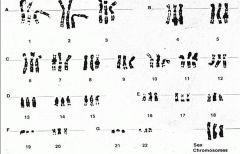
Given the characteristics:
Newborn born alive and quickly died with low apgar scores. could not resuscitate. Very small for gestational agae. very dysmorphic. very abnormal cardiac defect. Child has (see figure). What is the diagnosis and associated features? |
|
|
What is the definition of aneuploidy?
|
One missing or extra chromosome (45 or 47)
|
|
|
Aneuploidy
Trisomy 21 (down's Syndrome) 1/800 livebirths 95% due to true trisomy Risk increases with maternal age 5% due to translocations |
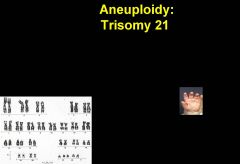
Given the Characteristics:
dysmorphic face, duodenal atresia, mental retardation, hypotonia, leukemia, heart defect What is the diagnosis and associated features? |
|
|
Aneuploidy
Trisomy 18 a.k.a Edwards Syndrome 1/8000 livebirths 80% due to true trisomy Risk increases with maternal age 20% due to unbalanced translocations |
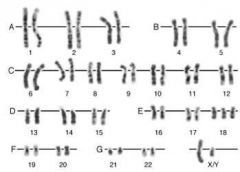
Given these characteristics:
hand clench, omphalocele, heart defects, mental retardation, rocker bottom feet, horseshoe kidneys What is the diagnosis and the associated features? |
|
|
Aneuploidy: Trisomy 13
a.k.a. Patau Syndrome 1/15,000 livebirths 80% due to true trisomy Incidence increases with maternal age 20% due to unbalanced translocation |
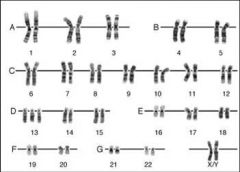
Given these characteristics:
midline defects (cyclopia, holoprosencephaly, heart defects, cleft lip, neural tube defects, polydactyly What is the diagnosis and associated features? |
|
|
Aneuploidy: Monosomy X
a.k.a. Turner Syndrome 1/2500 livebirth females >99% miscarry in utero 50% due to monosomy X (45,X) 50% due to other: i(Xq); mosaicism |
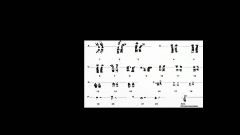
Given the Characteristics:
short stature, webbed neck, shield chest, ovarian dysgenesis, coarctation of aorta What is the diagnosis and associated features? |
|
|
Aneuploidy: 47, XXY
Klinefelter Syndrome 1/850 livebirth males 85% due to aneuploidy: 47, XXY More often due to paternal meiosis problem Risk increase with advancing maternal age 15% are mosaic |
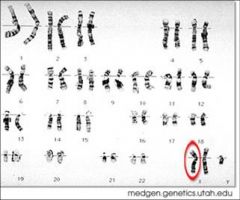
Given the characteristics:
Hypogonadism, Infertility, Tall stature, Gynecomastia What is the diagnosis and associated features? |
|
|
Describe aneuploidy 47, XYY
|
a.k.a. the SuperMale:
Incidence: 1/ 1000 livebirth males Due to paternal meiotic nondisjunction Features: tall stature, increased behavioral problems No increased risk for psychopathology |
|
|
Describe aneuploidy trisomy X (47,XXX)
|
a.k.a. the SuperFemale
Incidence: 1/1000 livebirth females Due to maternal meiotic nondisjunction Features: increased behavioral/ learning problems |
|
|
What are some cancers related to smoking both major causes and contirbutory factors?
|
Major cause:
Lung, larynx, oral, cavity, esophagus Contirbutory factor: Pancrease, bladder, Kidney, stomach, uterine cervix |
|
|
What are some alcohol reltated cancers?
|
Esophageal
Head and neck liver breasts |

